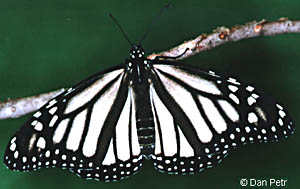 The White Monarch Authors: Authors:Lawrence Gibbs and Orley R. Taylor Department of Entomology University of Kansas June 1998 Though one's vision of the Monarch butterfly conjures up an image of a brilliant orange and black winged-insect, there exists a rare variation of the Monarch that "pales" in comparison. A white Monarch, named nivosus by Lepidopterists, is grayish white in all areas of the wings that are normally orange (Vane-Wright 1993). Several authors (Stimson and Meyers, 1984; Vane-Wright 1993) have assumed that the white form results from the inability of the butterfly to synthesize the normal orange pigment, but this hypothesis has never been tested. The white Monarchs appear to be normal in all other respects giving rise to many questions. Why is this form so rare? Is nivosus selectively eaten by predators? Does it have difficulty finding mates? Is the genetic basis for this form the same in all populations? These, and many other questions, need to be answered. We hope to have answers to some of these questions in the coming year. Distribution and Origin The existence of white forms within other species of Danaus, such as the Austro-Oriental D. melanippus and all the races of the Wallacean species D. ismare, suggests that nivosus could easily have arisen independently in the widely separated Monarch (Danaus plexippus) populations (Vane-Wright 1986). An alternative hypothesis is that the nivosus Monarch found in Hawaii, Australia, New Zealand and Moluccas might have been the result of recombination of a rare but homologous allele, inherited directly from their American ancestors (Vane-Wright 1986). Genetics Wing Pigmentation Predation However, the levels of cardiac glycosides in the tissues of Monarchs in Hawaii are low, apparently because leaves of the major host plant, Calotropis gigantea (crown flower) contain a low amount of these compounds. Possibly because of the low cardenolid content, both the white and orange forms are preyed upon by birds called bulbuls, Pycnonotus jacosus and Pycnonotus cafer on the Hawaiian island of Oahu (Stimson and Meyers, 1984). Curiously, the frequency of the white morph in Oahu, has increased in the last 20 years and now approaches 10% in some areas (Stimson and Meyers, 1984; Stimson and Berman, 1990). This increase could be due to predation. At Monarch feeding and ovipositing sites more orange Monarch wings have been found than expected based on the frequency of the orange form in the population. This suggests that predation is lower for white morphs (Stimson and Bergman, 1990) and raises the possibility that the white form is more cryptic (hard to see) to the bulbuls than the orange form. This interpretation is supported by observations from other Hawaiian islands which lack bulbuls. The white form occurs at a relatively low frequency or is lacking on islands without bulbuls (Stimson and Bergman, 1990). Additional studies are needed to determine whether selective predation of white vs. orange Monarchs is due to levels of cardiac glycosides or the ability of the bulbuls to "see" the white form. We should also keep in mind that the increase in the frequency in nivosus could be due to other, as yet unrecognized, selective factors.
Bibliography Kayser, Hartmut. 1985. Pigments. In Kerkut, G. A. and L. I. Gilbert [eds.], Comprehensive Insect Physiology, Biochemistry, and Pharmacology. 10: 367-415. Pergamon Press Ltd, New York. Minno, Marc. 1996. White Monarchs found in Florida. New of the Lepidopterists' Society. 38 (4): 184, 190. Nijhout, Frederik H. 1991. The Development and Evolution of Butterfly Wing Patterns. Smithsonian Institution, Washington D.C. Stimson, J. and L. Meyers. 1984. Inheritance and frequency of a color polymorphism in Danaus plexippus (Lepidoptera: Danaidae) on Ohahu [sie!], Hawaii. Journal of Research on the Lepidoptera. 23: 153-160. Stimson, J. and M. Berman. 1990. Predator induced colour polymorphism in Danaus plexippus L. (Lepidoptera: Nymphalidae) in Hawaii. Heredity. 65: 401-406. Vane-Wright, R. I. 1986. White Monarchs. Antenna. 10(3): 117-118. Vane-Wright, R. I. 1993. The Columbus Hypothesis: An Explanation for the Dramatic 19th Century Range Expansion of the Monarch Butterfly. In Malcolm, S. B. and Myron P. Zalucki [eds.], Biology and Conservation of the Monarch Butterfly. 38: 179-187. Natural History Museum of Los Angeles County. Vane-Wright, R. I. 1997. Florida White Monarchs - a touch of incest? News of the Lepidopterists' Society. 39(4): 72, 88. |
All material on this site © Monarch Watch unless otherwise noted. Terms of use.
Monarch Watch (888) TAGGING - or - (785) 864-4441
monarch@ku.edu